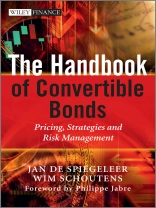This is a complete guide to the pricing and risk management of
convertible bond portfolios. Convertible bonds can be complex
because they have both equity and debt like features and new market
entrants will usually find that they have either a knowledge of
fixed income mathematics or of equity derivatives and therefore
have no idea how to incorporate credit and equity together into
their existing pricing tools.
Part I of the book covers the impact that the 2008 credit crunch
has had on the markets, it then shows how to build up a convertible
bond and introduces the reader to the traditional convertible
vocabulary of yield to put, premium, conversion ratio, delta,
gamma, vega and parity. The market of stock borrowing and lending
will also be covered in detail. Using an intuitive approach based
on the Jensen inequality, the authors will also show the advantages
of using a hybrid to add value – pre 2008, many investors labelled
convertible bonds as ‘investing with no downside’, there are of
course plenty of 2008 examples to prove that they were wrong. The
authors then go onto give a complete explanation of the different
features that can be embedded in convertible bond.
Part II shows readers how to price convertibles. It covers the
different parameters used in valuation models: credit spreads,
volatility, interest rates and borrow fees and Maturity.
Part III covers investment strategies for equity, fixed income
and hedge fund investors and includes dynamic hedging and
convertible arbitrage.
Part IV explains the all important risk management part of the
process in detail.
This is a highly practical book, all products priced are real
world examples and numerical examples are not limited to
hypothetical convertibles. It is a must read for anyone wanting to
safely get into this highly liquid, high return market.
Tabla de materias
Reading this Book.
Preface.
Acknowledgements.
PART I THE CONVERTIBLES MARKET.
1 Terminology.
1.1 The Payoff.
1.2 Advantages of Convertibles.
1.3 Basic Terminology.
1.4 Advanced Terminology.
1.5 Legal Terminology.
1.6 Analytics and Hedge Ratios.
2 Convertible Bond Anatomy.
2.1 Payoff to the Investor.
2.2 Payoff Graph.
2.3 Boundary Conditions.
2.4 Effect of the Call Protection.
2.5 Announcement Effect.
3 Convertible and Hybrid Structures.
3.1 Preferred Shares.
3.2 Convertible Bond Option.
3.3 Reverse Convertible.
3.4 Perpetuals.
3.5 Cross-Currency.
3.6 Mandatory.
3.7 Cashout Option.
3.8 Exchangeable.
3.9 Dividend Entitlement.
4 Convertible Bonds Market.
4.1 The Convertible Universe.
4.2 The Prospectus.
4.3 The Investors.
4.4 Market Participants.
4.5 New Issuance.
PART II PRICING.
5 The Road to Convexity.
5.1 Break-Even Analysis.
5.2 Discounted Yield Advantage.
5.3 Convexity.
5.4 Jensen’s Inequality.
5.5 Time Decay.
5.6 Double-Signed Gamma.
5.7 Colour.
5.8 First Steps Using Convexity.
6 Basic Binomial Trees.
6.1 Models.
6.2 The Basic Ingredients.
6.3 A Primer in Stochastic Calculus.
6.4 Elementary Credit Model.
6.5 Binomial Equity Models.
6.6 Pricing Convertibles Using Binomial Trees.
6.7 Credit Spread Modelling in Binomial Trees: A Practitioner’s Approach.
6.8 Conclusions.
7 Multinomial Models.
7.1 Convergence of the Binomial Model.
7.2 Moments.
7.3 Multinomial Models.
7.4 Trinomial Model.
7.5 Heptanomial Model.
7.6 Further Optimization.
7.7 Other Refinements.
7.8 Resets in Multinomial Models.
8 Ascots.
8.1 Risk Components of a Convertible.
8.2 Asset Swaps.
8.3 Ascots.
8.4 Advantages for the Credit Buyer.
8.5 Advantages for the Ascot Buyer.
8.6 Pricing of Ascots.
8.7 Ascot Greeks.
8.8 CB Warrants.
PART III RISK MANAGEMENT AND STRATEGIES.
9 Measuring the Risk.
9.1 Portfolio Risk.
9.2 A Portfolio in Trouble.
9.3 Risk Categories.
9.4 Coherent Risk Measures.
9.5 Option Greeks.
9.6 Fixed Income Measures.
9.7 Cross Greeks.
9.8 Speed and Colour.
9.9 Va R and Beyond.
9.10 Back Testing.
9.11 Stress Testing.
10 Dynamic Hedging.
10.1 Hedge Instruments.
10.2 Delta Hedging.
10.3 Volatility.
10.4 Gamma Trading.
10.5 The Variance Swap.
11 Monte Carlo Techniques for Convertibles.
11.1 Adding More Realism.
11.2 Monte Carlo Method.
11.3 American Monte Carlo.
References.
Index.
Sobre el autor
Jan De Spiegeleer (Geneva, Switzerland) is Head of Risk
Management at Jabre Capital Partners, a Geneva-based hedge fund. He
developed an extensive knowledge of derivatives pricing, hedging
and trading while working for KBC Financial Products in London,
where he was Managing Director of the equity derivatives desk.
Prior to his financial career, Jan worked for ten years as an
officer in the Belgian Army, and served in Iraq.
Wim Schoutens (Leuven, Belgium) is a research professor
in financial engineering in the Department of Mathematics at the
Catholic University of Leuven, Belgium. He has extensive practical
experience of model implementation and is well known for his
consulting work to the banking industry and other institutions. Wim
is the author of Lévy Processes in Finance and
Lévy Processes in Credit Risk, and co-editor of
Exotic Option Pricing and Advanced Lévy Models all
published by John Wiley and Sons. He is Managing Editor of the
International Journal of Theoretical and Applied Finance and
Associate Editor of Mathematical Finance, Quantitative
Finance and Review of Derivatives Research.












